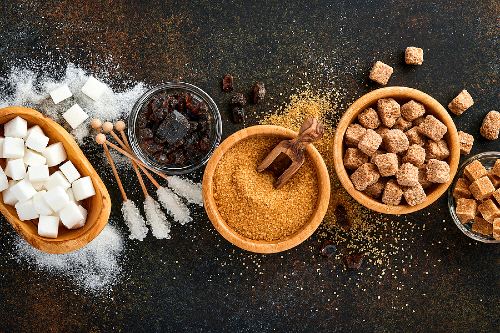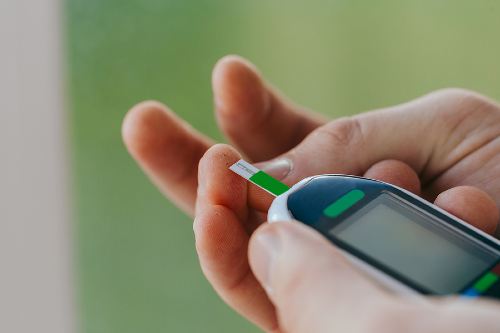We all know and love the sweet taste of sugar, but what do we really know about the sweetener?
Sugar goes by many different names: sucrose, high fructose corn syrup, added sugar, Sugar in the Raw, and so many more. Sugar knockoffs, like no-calorie sweeteners and Sweet and Low, are also thrown into the mix.
But which sugar is the best for your body? How much sugar is too much? We’ll be answering many of your questions about sugar in a two-part series of blog posts. This post will include:
- recommended daily sugar intakes,
- an overview of blood sugar,
- health consequences of eating too much sugar, and
- a chance for you to become an added sugar expert!

Experts say: Limit your added sugar.
Did you know that the average American adult consumes more than 3 times the recommended amount of added sugar every day? [1] It can be difficult to know what foods contain added sugar which can lead to eating too much.
Some foods have sugar in them naturally, like fruit and milk. These sugars are called “natural sugars.” Other foods have “added sugar”, meaning they had sugar added to them during processing or preparation, such as sugar-sweetened breakfast cereal or the teaspoon of sugar you add to your morning coffee.
There are no recommendations to limit natural sugars. However, added sugars should be limited as they can increase the risk for various health concerns like Type 2 diabetes, heart disease, and high blood pressure.
The 2020-2025 Dietary Guidelines for Americans (DGA) recommend limiting added sugars to less than 10% of your daily calories. [2] Experts agree that going over your added sugar allowance can make it hard to eat enough nutritious foods and still stay within your daily calorie limit. [3] Consuming too much added sugar can lead to you eating more calories than needed or not eating enough foods high in fiber, vitamins, or minerals. To learn more about ways you can cut back on added sugars, check out this MyPlate tip sheet.
So what does added sugar look like in real life? See the graphic below for an example!

Glucose vs. Carbohydrates: What is the difference?
Blood sugar is actually just another way to say blood glucose. Glucose is the main form of sugar that we eat, and what you eat regulates the amount of glucose in your blood. Glucose comes from carbohydrates, both healthy (like whole-grain bread or yogurt) and less healthy sources (like soda or sweetened muffins).
If you eat foods high in carbohydrates, your blood glucose can increase. If you don’t eat enough carbohydrates, your blood glucose can fall. The type of carbohydrate you choose matters a lot! Try to choose the more nutritious option.
If someone has consistently high blood glucose levels the American Diabetes Association refers to this as Type 2 Diabetes. People with diabetes have to carefully manage their blood glucose levels since their bodies cannot manage levels on their own. Learn more about diabetes here.

How can too much sugar affect my health?
Consuming excess sugar can have negative health consequences. To name a few:
- Too many sources of added sugar in your diet can lead to weight gain (which in turn can increase your risk for Type 2 diabetes).
- Your risk of developing cavities in your teeth increases when you consume high amounts of sugar.
- Drinking sugar-sweetened beverages have specifically been linked to Type 2 diabetes development. [4] As little as 1-2 sugary beverages per day can double your risk for Type 2 diabetes! [5] For more information on picking the right beverage choice for you, click here!
Following the DGA recommendations of daily added sugar, eating a balanced diet, and staying active can help prevent your risk!

Think you know which foods have more sugar?
Most can tell you that sugar is in familiar foods and drinks like cakes, cookies, and sodas, but did you know sugar is also added to bread, ketchup, nut butters, salad dressing, spaghetti sauce, baked beans, BBQ sauce, and some frozen vegan foods?
Let’s play a game. Choose from the following pictures which items have more than 10 grams of added sugar. Find the answers below!

ANSWERS:
Watermelon=0 g added
Sugared cereal= 12 g added [6]
Yogurt= 0 g added (Note: this is for plain yogurt. Many yogurts do contain added sugar! Be sure to check the nutrition facts label to see how much added sugar is in your yogurt).
Sports drink= 48 g added [7]
We hope this blog has been informative and has helped you understand sugar and its various sources. Be on the lookout for All About Sugars Part 2 to come soon!
Written by Taylor Newman, Ph.D., RDN, LD, and Darci Bell, RDN, LD | Reviewed by Leslie Davis, MS, RD, LD, CDCES, and the Nutrition Education Team
Posted: November 1, 2021
[1] American Heart Association
[2] Dietary Guidelines for Americans